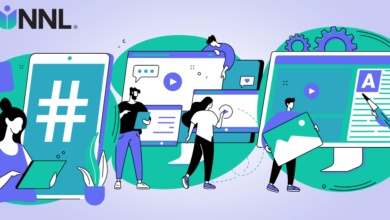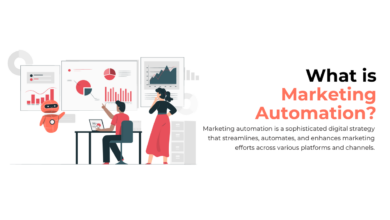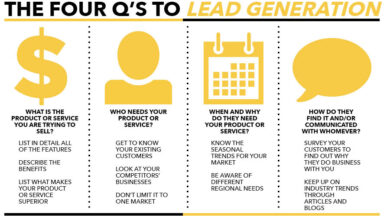
Conversion Rate Marketing Explained A Deep Dive
Conversion rate marketing explained is a crucial aspect of online business success. It’s not just about attracting visitors; it’s about understanding how to transform those visitors into paying customers. This exploration delves into the core principles of improving conversion rates, from defining the concept to optimizing user experiences and leveraging the right tools.
We’ll examine the relationship between conversion rates and overall business goals, exploring the stages of the conversion funnel. Different marketing approaches, such as , social media, and paid advertising, will be compared in terms of their impact on conversion rates. Understanding key performance indicators (KPIs) is essential, and we’ll explore metrics for e-commerce and lead generation. Strategies for optimizing the user experience, A/B testing, and analyzing user behavior will also be covered.
Finally, we’ll discuss content strategy and essential tools for conversion rate optimization, such as Google Analytics and Hotjar.
Introduction to Conversion Rate Marketing

Conversion rate marketing is a strategic approach focused on optimizing the percentage of website visitors who complete a desired action, like making a purchase or signing up for a newsletter. It’s not just about attracting more traffic; it’s about converting that traffic into valuable customers. This means understanding the entire customer journey and fine-tuning each touchpoint to maximize the likelihood of a desired outcome.The core principles of improving conversion rates revolve around understanding customer behavior and tailoring the website experience to meet their needs.
This involves analyzing data to identify pain points, testing different strategies, and continually iterating on what works best. Ultimately, conversion rate optimization (CRO) is about driving efficiency in marketing efforts by maximizing the value derived from each visitor.
Relationship Between Conversion Rate and Business Goals
Conversion rate directly impacts key business goals. A higher conversion rate translates to more revenue, leads, and customers for the same amount of marketing spend. For example, a 5% increase in conversion rate can significantly boost profitability, especially for businesses with a high volume of website traffic. This directly ties to improved return on investment (ROI) for marketing campaigns.
Conversion Funnel Overview
The conversion funnel visually represents the customer journey from initial awareness to final action. It highlights the stages a potential customer goes through before becoming a paying customer. Understanding these stages allows marketers to optimize each step to enhance the conversion rate. The funnel typically comprises stages like awareness, interest, decision, and action.
Comparison of Marketing Approaches
Different marketing strategies have varying impacts on conversion rates. Search Engine Optimization () typically drives organic traffic, which often leads to higher conversion rates due to the targeted nature of the search queries. Social media marketing, while effective for brand awareness and engagement, might not always have the same direct correlation with immediate conversions. Paid advertising campaigns can be highly targeted and effective in driving conversions, but they often require careful budgeting and optimization to ensure profitability.
Stages of the Conversion Funnel
| Stage | Description | Example | Metrics |
|---|---|---|---|
| Awareness | This stage focuses on making potential customers aware of your product or service. It’s about creating initial interest and recognition. | A user sees an advertisement on social media or a search result for a product they need. | Website traffic, social media engagement, impressions, reach. |
| Interest | Here, potential customers show a deeper engagement with your brand. They are actively researching and exploring your offerings. | A user browses product pages on your website, watches product videos, or reads blog posts related to your product. | Time spent on site, pages viewed, bounce rate, click-through rate. |
| Decision | This critical stage involves the customer actively considering their options and making a purchasing decision. | A user compares your product to competitors, reviews customer testimonials, and considers the pricing. | Conversion rate from interest to decision stage, cart abandonment rate, product comparisons. |
| Action | The final stage where the customer completes the desired action, like making a purchase or signing up. | A user adds an item to their cart and proceeds to checkout. | Conversion rate, average order value, customer lifetime value. |
Key Performance Indicators (KPIs) in Conversion Rate Marketing

Conversion Rate Optimization (CRO) is a data-driven approach. Understanding and effectively tracking key performance indicators (KPIs) is crucial for measuring the success of your CRO efforts. These KPIs provide actionable insights into what’s working, what’s not, and where to focus improvements to boost conversions. By analyzing these metrics, businesses can refine their strategies, optimize their website and marketing campaigns, and ultimately drive higher conversion rates.Effective CRO hinges on meticulous tracking and analysis of relevant KPIs.
Conversion rate marketing is all about optimizing your website and social media presence to boost the percentage of visitors who actually take desired actions, like making a purchase or filling out a form. A crucial part of this is creating a strategic social media posting schedule, like the one outlined in this helpful guide: how to make a social media posting schedule.
By carefully planning your content and posting times, you’ll increase visibility and ultimately, drive more conversions. Understanding your audience and tailoring your messaging is key to conversion rate marketing success.
This allows businesses to pinpoint areas for improvement, identify bottlenecks in the customer journey, and refine strategies to enhance the overall user experience, resulting in increased conversions. A strong understanding of these metrics empowers businesses to make data-driven decisions and optimize their marketing spend for maximum impact.
Essential KPIs for Measuring Conversion Rate Performance
Conversion rates, while crucial, are not the only indicator of success. A comprehensive approach involves monitoring a range of metrics that reflect various aspects of the customer journey. This holistic view allows for a more nuanced understanding of the factors influencing conversions. These metrics often work in tandem to provide a complete picture of campaign effectiveness and user behavior.
KPIs for Different Industries and Business Types
Businesses in diverse sectors have unique conversion goals. Identifying relevant KPIs tailored to specific business types provides a more focused approach to measuring success. For example, an e-commerce store will focus on metrics like average order value, while a SaaS company might prioritize customer lifetime value.
- E-commerce: Conversion rate, average order value (AOV), cart abandonment rate, bounce rate, and customer lifetime value (CLTV).
- Lead Generation: Lead generation cost, lead response rate, conversion rate, lead quality score, and customer acquisition cost (CAC).
- SaaS: Churn rate, customer lifetime value (CLTV), monthly recurring revenue (MRR), and customer satisfaction (CSAT).
- Real Estate: Number of property views, lead follow-up rate, conversion rate from lead to contract, and customer satisfaction (CSAT).
Interpreting and Using KPI Data to Improve Conversion Rates
Analyzing KPI data is not just about recognizing numbers; it’s about understanding the underlying trends and patterns. Identifying trends in data allows businesses to proactively address issues and adjust strategies.
- Analyzing trends: Identifying patterns in the data, such as seasonal fluctuations or changes in user behavior, can reveal opportunities for optimization. For example, a drop in conversion rates during a specific period might indicate a need to adjust marketing campaigns or improve the website’s performance during that time.
- Identifying bottlenecks: KPIs highlight bottlenecks in the customer journey. A high bounce rate on a specific page might suggest issues with the content, design, or user experience on that page. By identifying these bottlenecks, businesses can implement targeted improvements.
- Testing and optimization: Testing different strategies based on KPI data allows businesses to fine-tune their approach. For instance, A/B testing different versions of a landing page can help optimize conversion rates. These tests can involve modifying headlines, call-to-actions, or even the layout of the page.
Comparison of KPIs for E-commerce vs. Lead Generation
The table below highlights key KPIs relevant to both e-commerce and lead generation. Each KPI’s interpretation and importance differ significantly between these two business models.
| KPI | E-commerce | Lead Generation |
|---|---|---|
| Conversion Rate | Percentage of visitors who complete a purchase. | Percentage of leads who convert into paying customers. |
| Average Order Value | Average amount spent per transaction. | Average revenue generated per lead. |
| Bounce Rate | Percentage of visitors who leave the website after viewing only one page. | Percentage of leads who do not engage with follow-up communications. |
| Cart Abandonment Rate | Percentage of shoppers who add items to their cart but do not complete the purchase. | Not applicable. |
| Customer Lifetime Value (CLTV) | Total revenue generated from a customer over their relationship with the business. | Total revenue generated from a lead over their relationship with the business. |
| Customer Acquisition Cost (CAC) | Cost of acquiring a new customer. | Cost of acquiring a new lead. |
Strategies for Improving Conversion Rates
Conversion rate optimization (CRO) isn’t just about making your website look pretty; it’s about understanding and responding to user behavior to drive more conversions. Effective CRO strategies focus on enhancing the entire user journey, from initial landing page view to final purchase or lead generation. This involves analyzing every interaction, identifying friction points, and refining the experience to make it more intuitive and compelling.Improving conversion rates requires a multifaceted approach that combines user experience design, data analysis, and iterative testing.
Conversion rate marketing is all about optimizing your website and campaigns to get more people to take the desired action, like buying a product or signing up for a newsletter. It’s a crucial aspect of any online business, and understanding how it works is key. Knowing how to boost conversions often involves a deeper look at other strategies, like affiliate marketing, which is all about promoting other people’s products and services.
For a complete understanding of affiliate marketing marketing explained, check out this helpful resource: affiliate marketing marketing explained. Ultimately, a strong grasp of conversion rate marketing principles is essential for success in today’s digital landscape.
It’s not a one-time fix but a continuous process of refinement and optimization. A deep understanding of user behavior is key to understanding where to focus efforts and achieving tangible results.
Conversion rate marketing is all about boosting the percentage of visitors who actually buy something. A key part of this is understanding what’s happening with those potential customers who leave their items in their online shopping cart. This is where techniques like abandoned cart marketing explained come in, helping you recover those lost sales. Ultimately, conversion rate marketing is a multifaceted strategy, and understanding these nuances is crucial for online success.
Optimizing User Experience
User experience (UX) is paramount in conversion rate marketing. A seamless and intuitive experience keeps users engaged and encourages them to complete desired actions. This includes clear navigation, easily digestible content, and a visually appealing layout. Poor UX can lead to frustration and abandonment, ultimately impacting conversion rates. A well-designed UX, on the other hand, fosters trust and encourages interaction, leading to a higher likelihood of conversions.
Website Usability and Design
Website usability and design directly influence conversion rates. A user-friendly site allows visitors to easily find what they need, leading to a positive experience and increased engagement. This includes clear calls-to-action (CTAs), logical site architecture, and intuitive navigation. Websites that are difficult to navigate or understand can deter visitors and drive them away from completing desired actions.
Well-designed websites with clear layouts and concise information contribute to a more positive user experience and improved conversion rates.
A/B Testing for Optimization
A/B testing is a powerful tool for optimizing website elements to maximize conversion rates. It involves creating two versions of a webpage or element (A and B) and comparing user responses to each. This allows marketers to determine which version performs better and implement the more effective design. The key to successful A/B testing lies in meticulously choosing elements to test and carefully measuring the results.
Examples of Successful A/B Testing, Conversion rate marketing explained
A successful A/B test often involves changing a single element of a webpage, such as the color of a button, the wording of a headline, or the placement of a call-to-action. One example is changing the button color from blue to green, which, after A/B testing, resulted in a 15% increase in click-through rates. Another example involves adjusting the headline to be more concise and action-oriented, resulting in a 10% increase in conversion rates.
Analyzing User Behavior
Analyzing user behavior provides valuable insights into how visitors interact with a website. This can reveal areas of friction, confusion, and potential improvement. Tools like heatmaps, scroll maps, and clickstream data can help visualize user behavior patterns and pinpoint specific areas that need optimization. This data can then inform design changes to make the website more intuitive and engaging.
Mobile Optimization for Conversions
Mobile optimization is crucial for conversion rate marketing in today’s mobile-first world. A significant portion of website traffic comes from mobile devices. A mobile-friendly website ensures a positive experience for all users, regardless of the device they are using. Poor mobile optimization can lead to a poor user experience, increased bounce rates, and ultimately, lower conversion rates.
Clear Calls-to-Action (CTAs)
Clear and compelling calls-to-action (CTAs) are essential for guiding users toward desired actions. They need to be prominent, easily understood, and visually engaging. A well-designed CTA encourages users to take the next step in the conversion funnel. Ambiguous or poorly designed CTAs can lead to missed opportunities and lower conversion rates.
CTA Design and Effectiveness
Different CTA designs can significantly impact their effectiveness. Testing various colors, fonts, and styles can reveal which combinations resonate best with target audiences. A well-crafted CTA will encourage users to take the desired action, whether it’s making a purchase, signing up for a newsletter, or requesting a quote. Analyzing the performance of different CTA designs helps optimize their effectiveness and enhance conversion rates.
Content Strategy for Conversion Rate Optimization
High-quality content is the lifeblood of any successful conversion rate optimization (CRO) strategy. It’s not just about filling your website with words; it’s about creating valuable experiences that resonate with your target audience and move them through the sales funnel. Effective content attracts visitors, nurtures leads, and ultimately, converts them into paying customers.Content isn’t a one-size-fits-all solution. To maximize its impact, it must be carefully crafted and tailored to specific stages of the customer journey.
Understanding your audience’s needs and pain points is crucial for developing content that truly speaks to them. From informative blog posts to engaging videos, your content should provide value and position your brand as a trusted authority.
Importance of High-Quality Content
High-quality content builds trust and credibility with potential customers. It showcases expertise, positions your brand as a thought leader, and helps establish a strong online presence. This, in turn, leads to increased brand awareness, higher click-through rates, and ultimately, a higher conversion rate. Content that resonates with the audience fosters engagement and encourages deeper exploration of your offerings.
Content Formats for Engagement
Various content formats can be employed to capture and maintain audience interest. A diverse approach can significantly enhance engagement and cater to different learning styles. Consider these formats:
- Blog posts: Informative and engaging articles that address specific needs and pain points of your target audience. They can range from industry news to how-to guides, showcasing your expertise and building trust. For example, a plumbing company could publish blog posts on common plumbing problems and solutions, establishing them as a reliable resource.
- Videos: Videos can convey information more dynamically and engagingly, especially when combined with visuals. They can explain complex topics, demonstrate product use, or share company stories. For example, a software company could use video tutorials to guide users through the software interface, making the product easier to understand and use.
- Infographics: Visually appealing graphics that present complex information in a digestible format. Infographics can quickly communicate key data points and highlight key benefits, making them highly shareable and effective in attracting attention. For example, a financial institution could use infographics to explain different investment strategies.
- Case studies: Detailed accounts of successful projects or campaigns that highlight the positive outcomes of using your products or services. They provide social proof and demonstrate the value you offer, building trust and credibility. For instance, a marketing agency could showcase a case study of a successful campaign that increased a client’s lead generation by 50%.
- Ebooks and white papers: In-depth resources that provide valuable information on specific topics related to your industry. These longer-form pieces position your brand as a thought leader and encourage lead generation. For example, a SaaS company could create an ebook on best practices for project management.
Tailoring Content to Conversion Funnel Stages
Effective content should address each stage of the conversion funnel. Understanding how your content can support users at different stages of their journey is vital for optimization.
- Awareness stage: Content at this stage focuses on educating potential customers about your industry and your brand. Examples include blog posts, social media updates, and general marketing materials that create a foundational understanding of your offerings.
- Consideration stage: Content in this stage aims to show how your solution addresses specific needs or pain points. Examples include case studies, product demos, webinars, and detailed product descriptions. This is where you build credibility and encourage potential customers to consider your offering over competitors.
- Decision stage: This is where you provide strong calls to action and solidify the decision to convert. Examples include testimonials, customer reviews, and limited-time offers. Highlighting the benefits and advantages of choosing your product or service can sway decision-making.
Examples of Converting Content
Successful content often combines multiple formats and targets specific needs. Examples of content that performs well include:
- Interactive quizzes: These can gauge user needs and offer tailored solutions.
- Interactive calculators: They demonstrate value by providing quick results and potential savings.
- Templates and checklists: These practical resources help users complete tasks and save time.
Best Practices for Compelling Content
To create compelling and persuasive content, focus on these best practices:
- Know your audience: Understanding their needs, pain points, and preferences is crucial for creating relevant content.
- Write for humans, not search engines: Focus on clear, concise, and engaging language.
- Optimize for search engines: Utilize relevant s and meta descriptions to improve search engine visibility.
- Use visuals: Incorporate images, videos, and infographics to enhance engagement and understanding.
- Encourage interaction: Ask questions, run polls, and encourage comments to foster engagement.
Tools and Technologies for Conversion Rate Optimization: Conversion Rate Marketing Explained
Conversion rate optimization (CRO) isn’t just about tweaking buttons; it’s a data-driven process requiring the right tools. The best tools provide insights into user behavior, helping you understand what works and what doesn’t on your website. This understanding fuels decisions to improve user experience and ultimately boost conversions. Choosing the right tools is crucial for maximizing your CRO efforts.Advanced tools for conversion rate optimization provide a wealth of data on user behavior.
These tools, ranging from analytics platforms to A/B testing software, allow marketers to identify patterns and areas for improvement on their websites. Effective implementation of these tools often leads to measurable improvements in conversion rates.
Conversion Rate Analysis Tools
A fundamental part of CRO is understanding user behavior on your website. This involves analyzing how visitors interact with different elements, from landing pages to checkout processes. Robust tools provide detailed insights into user journeys and highlight friction points. By understanding what’s driving conversions and what’s hindering them, you can make informed decisions to improve the overall experience and encourage more conversions.
- Google Analytics: A comprehensive analytics platform, Google Analytics tracks user interactions, allowing for in-depth analysis of website traffic. It measures key metrics like bounce rate, session duration, and conversion rates. This data helps identify areas of the website that need improvement, such as pages with high bounce rates or lengthy checkout processes. It can also be integrated with other tools for a holistic view of the customer journey.
- Hotjar: Hotjar goes beyond page-level data, providing a user-centric view of website interactions. It uses heatmaps, recordings of user sessions, and surveys to understand how users navigate the site and identify pain points in the user experience. This deep dive into user behavior allows for more targeted improvements. For example, identifying a high concentration of mouse clicks in a specific area of a page could indicate a need to rearrange elements or make the call to action more prominent.
- VWO (Visual Website Optimizer): VWO is a popular A/B testing platform that facilitates experimentation to optimize conversion rates. It allows you to test different versions of web pages and identify the one that performs best. This enables you to make data-backed decisions about layout, design, and copy. For example, a simple change to a button color could significantly impact conversion rates.
A/B Testing and User Experience Analysis Tools
A/B testing allows you to compare different versions of a website element to determine which performs better. This iterative process of testing and refinement is crucial for continuous improvement. These tools provide a structured way to test different designs, copy, and layouts, ultimately leading to a higher conversion rate. User experience analysis tools provide insights into how users interact with the website.
These tools reveal crucial user pain points, allowing for improvements in navigation, clarity, and overall experience.
| Tool | Description | Pros | Cons |
|---|---|---|---|
| Google Analytics | Comprehensive analytics platform tracking website traffic and user behavior. | Provides detailed insights, robust reporting, free to use. | Can be overwhelming for beginners, requires technical setup. |
| Hotjar | User experience analysis tool offering heatmaps, recordings, and surveys. | Provides deep understanding of user behavior, identifies pain points. | Can be expensive, requires some technical understanding. |
| VWO | A/B testing platform enabling experimentation and optimization. | User-friendly interface, focused on testing and optimization. | May have limitations on free plan, can be costly for extensive testing. |
Final Summary
In conclusion, mastering conversion rate marketing is about understanding your audience, optimizing the customer journey, and utilizing the right tools. By consistently analyzing data, testing different strategies, and focusing on the user experience, businesses can significantly improve their conversion rates and achieve their overall goals. This detailed look at conversion rate marketing offers practical insights for anyone aiming to boost their online performance and drive profitable growth.





